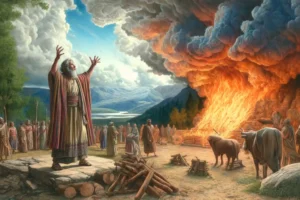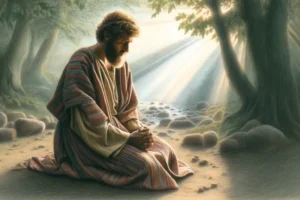
Jonah’s Prayer From the Fish
Quick Facts about Jonah’s Prayer from the Fish (Jonah 2:1-9):
- Context: Jonah’s prayer occurs inside the belly of a great fish, where he was swallowed after trying to flee from God’s command to go to Nineveh.
- Form of Prayer: The prayer is a poetic psalm of thanksgiving, not a typical plea for help, indicating Jonah’s faith in God despite his dire situation.
- Themes: The prayer centers on themes of distress, deliverance, and dedication. Jonah acknowledges his desperate state, celebrates God’s salvation, and commits to fulfilling his vows.
- Divine Intervention: Jonah credits his survival to God’s direct intervention, emphasizing God’s control over nature and His power to save.
- Symbolism of Sheol: Jonah describes his experience as being cast into the depths and the currents swirling about him, using language that parallels descriptions of Sheol, the place of the dead, symbolizing his near-death experience.
- Thanksgiving and Vow: The prayer concludes with thanksgiving and a vow to perform what he has promised, demonstrating a renewed commitment to obey God.
- Theological Insight: This prayer reflects the theology of repentance and redemption, highlighting that even in the depths of despair, God is present and ready to rescue those who call on Him.
Contextual Overview
Jonah’s prayer in Jonah 2:1-9 is set in a moment of deep personal and spiritual crisis. It is recited while he is inside the belly of a great fish, a unique setting that symbolizes both judgment and grace. This prayer follows Jonah’s attempt to flee from God’s command to prophesy against Nineveh, leading to his being thrown into the sea and swallowed by the fish.
Literary Form and Structure
The prayer is structured as a psalm of thanksgiving, rather than a plea for rescue, which is noteworthy given Jonah’s dire circumstances. This indicates that the prayer might have been composed post-deliverance as a reflective thanksgiving rather than a real-time supplication. It is poetic, employing vivid imagery and elements typical of Hebrew poetry such as parallelism and chiasmus.
Theological Themes
- Divine Sovereignty and Mercy: Jonah acknowledges God’s sovereignty over his situation. He describes being cast into the deep and enveloped by waters, using language that evokes images of chaos and divine wrath, yet it is God who commands the sea and the fish, showing His control over creation and mercy towards Jonah.
- Repentance and Salvation: The prayer reflects a theme of repentance. Jonah’s ordeal leads him to a recognition of his sin of disobedience. His prayer from the depths symbolizes a turning back to God in a literal and spiritual sense. The mention of being brought up from the pit suggests a form of resurrection, aligning Jonah’s physical salvation with spiritual renewal.
- Distress and Deliverance: Jonah uses traditional expressions of lament to describe his distress, referencing Sheol and the roots of the mountains, illustrating the extremity of his alienation from God. Yet, his deliverance by the fish, commanded by God, underscores a major theme: God’s willingness to save even when humans disobey, highlighting His gracious character.
- Vow Fulfillment: Jonah concludes with a promise to fulfill his vows. This commitment underscores the reciprocal nature of his relationship with God. It signals his renewed dedication to his prophetic mission, demonstrating that true thanksgiving to God is expressed through obedience.
Symbolic and Eschatological Significance
The imagery Jonah uses—being swallowed, engulfed by water, and then delivered—resonates with themes of death and resurrection. This has eschatological significance, later used by Jesus in the New Testament as a sign of His own death and resurrection (Matthew 12:40). Jonah’s experience prefigures Christ’s death and resurrection, providing a typological foreshadowing of the ultimate act of divine salvation.
Conclusion
Jonah’s prayer from the belly of the fish is a profound blend of personal lament, theological reflection, and prophetic symbolism. It not only marks a pivotal moment in Jonah’s personal journey but also enriches the biblical understanding of God’s mercy, human repentance, and the hope of salvation. The prayer serves as a powerful reminder of God’s omnipresence and His readiness to save, offering deep insights for theological reflection and spiritual growth.



